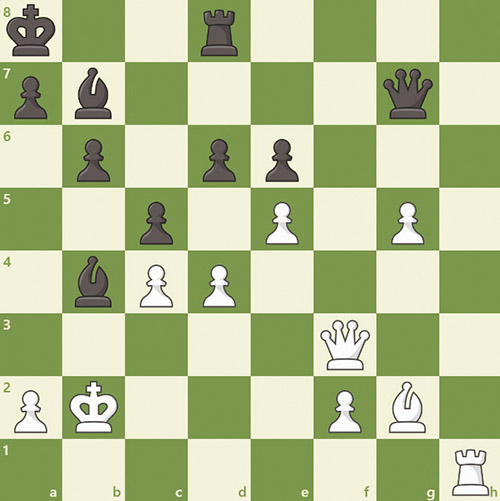
In chess, Zwischenzug, a German word meaning “in between move,” is an intermediate move to which one’s opponent must respond before playing the expected move during a tactical sequence. This concept is demonstrated by the position in Figure 1in which White is down a bishop for a pawn and has a far less safe king then Black. Here, the only move for White to equalize the game is playing Queen to f6, moving it out of danger to the f6 square where it is defended by two pawns and hits the Black queen. Because Black’s queen is attacked by White’s, Black cannot capture the hanging bishop on g2 and must either play queen to f8 or queen takes f6. After Qxf6, White then employs the idea of Zwischenzug and plays the in-between move Bxb7+, taking Black’s bishop on b7 with his bishop on g2 with a check, because if the natural recapture of the queen on f6 were made, Black would simply take the bishop on g2 and win material. Because it is a check, Black is forced to take back the bishop on b7 and only then does White take Black’s queen with his e-pawn, creating connected past pawns on the Queenside which results in a sharp but equal endgame.
Figure 2 is a position from a game played in 2005 between former five-time world champion Viswanathan Anand (White pieces) and Grandmaster Ruslan Ponomariov (Black pieces) in the Corus Group A. Anand began with 1. Qe3, moving the queen out of danger and preparing to attack on the kingside, followed by Qe7 and 2. Qg5, offering a Queen trade that would fix White’s kingside pawn structure. However, after Qxg5, Anand found the powerful in-between move: 3. Rf7 Rxf7 4. Rxf7+ Kh8, bringing White’s rook into the Queenside, preventing Black’s rook that was on f8 from aiding in the defense of the position and forcing the White king to the backrank (Kg8 would be met with Rg7+). Because White’s rooks check the king, Black is forced to respond to their presence and cannot use the time to prevent his queen from being recaptured. Only after this Zwischenzug did Anand play 5. Hxg5 Bc6, defending the knight, 6. B4 to control Queenside squares and Nf8 to protect the g6 and e6 pawns, as well as possibly preparing to transfer the knight to h7. 7. Rf6 Kg8 8. Bg4 Bd7 9. Kb2 Re8 and White continues to apply pressure on the queenside while Black is forced to make rather ugly, defending moves that hinder the activation of Black’s pieces. With 10. Nd1 Re7 11. Nf2 Be8, White begins to reroute his knight to the queenside as Blacks position grows more and more cramped. Attempting to alleviate the pressure and to gain more space, Black offers a rook trade with 12. Rf3 Rf7 13. Rxf7 Kxf7. However, while Black does achieve these goals, with rooks off the board, the position becomes far less tense and White simply now has to properly utilize his more active pieces (especially with a light square bishop that can attack all of Black’s pawns on light squares and can move freely past the White pawns mostly on dark squares), superior pawn structure and pawn up advantage. 14. Kc3 Nh7 15. Nh3 Bc6 16 Kd3 Ke7 and Anand successfully defended his position and went on to win the game 15 moves later.

In Figure 3, a position from a game between Grandmasters Boris Gelfud with the White pieces and Peter Svidler with Black, White is momentarily down a pawn and can immediately capture the pawn on f7, bringing the bishop into the Black king’s fortress and maintaining a slight advantage. However, after Bxf7, Black’s rook on the c file applies sufficient pressure to neutralize much of White’s attack as Black then has Be2, and if Queen takes the bishop, Black can take the knight on c7 with his rook; if, instead of Qxe2, White plays Rd7, Black can bring his bishop back to b5 to attack the rook and the knight cannot capture it because it is pinned to the rook on c1. To prevent this idea White has the in-between move Be6, hitting the rook and if it is captured, Nxe6 is completely winning for White. If the rook moves out of the attack. as was played in the game, then White takes the pawn on f7 and Be2 fails to Rd7; if Black plays Bb5 like before, White can now take the bishop with his knight as it is no longer pinned to the rook on c.
Figure 4 is a more simple position from the Moscow Team Championship of 1971 between Alexander Kotov and Ratmir Kholmov that utilizes a Zwischenzug tactic, along with major pins, to allow for a brilliant move for White. Here, the only winning move is Queen to b5, further attacking the rook on c5, which is both pinned to the rook on c8 and the Queen on a7, preventing it from moving at all. If Rxc2 then White wins the exchange with Bxa7. and if Rxb5 attempting to trade Queen for Queen, White has the in-between move Rxc8 with a check; Black is then forced to play King to f7 and only then does White play Bxa7, winning the rook.
Ethan Feder is a junior at Yeshivat Frisch, a chess enthusiast and player. The goal of his column is to teach and discuss chess concepts through example positions, high-level games and relevant puzzles, along with explanations. Feel free to contact him with any questions, suggestions or comments at [email protected].












